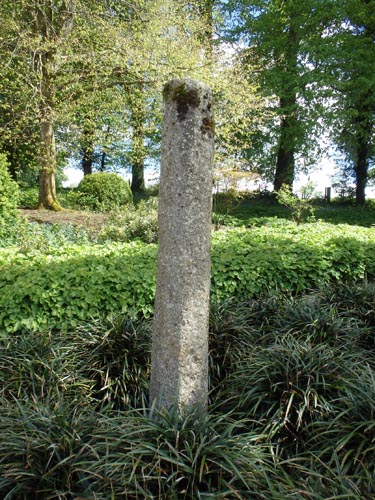 Location:
Standing
in
the garden of Buckland Abbey, near the barn. Location:
Standing
in
the garden of Buckland Abbey, near the barn.
O/S Grid Ref:
SX/48778/66765
Longitude/Latitude (Degrees+/-): -4.13280/50.48113
Map location:
Click here
to view map.
Purpose: Not
known.
Size:
Not yet measured.
Information: This
granite cross shaft was found during the demolition of a property opposite
the City Museum, in Tavistock Road, Plymouth. The shaft is square at its
base and chamfered above, where it becomes octagonal in section. It
tapers slightly upwards and there is a dowel hole in the top of the
shaft. After being found, it was kept in a yard behind the museum
for some time, before being sited in its current position in the Abbey
gardens. Buckland
Abbey was founded in 1278 and was the last, and most westerly, Cistercian
monastery to be built in medieval England and Wales. For over 250 years,
the monks who farmed the vast estate lived in the peaceful solitude of the
Tavy valley. The Dissolution of the Monasteries, during the reign of Henry
VIII, saw Buckland sold to Sir Roger Grenville in 1539. It was
Grenville who began to modify the abbey into a house and home and, later,
he sold the estate to Sir Francis Drake, the first Englishman to
circumnavigate the globe. The estate remained in the Drake family
for around 400 years until, following a fire in 1938, it was sold to
Captain Rodd, who presented it to the National Trust in 1948. The Abbey garden itself was mainly landscaped in the
1950s and features
camellias, rhododendrons and magnolias. From here, you can see right
across the valley to the woodland which stretches down to the river Tavy. The
Cider House and its gardens were purchased back into Trust ownership in
2011. The tower is thought once to have been part of the Abbot's
lodgings, originally built in the 15th century. The
property has been open to the public since 1951 and today's visitors can
also enjoy a stroll around the 650 acre estate. To
the north east of the abbey church, the rising ground contains three
quarries from which the shillet (Upper Devonian slate) was extracted for
the construction of the abbey. Along with the nearby Abbeys of
Tavistock and Plympton, Buckland Abbey was at the western end of the
Abbot's Way track that runs across the southern moor, from Buckfast Abbey.
Our
thanks go to Robert Noakes for supplying
the photo and bringing
this cross to our attention.
|